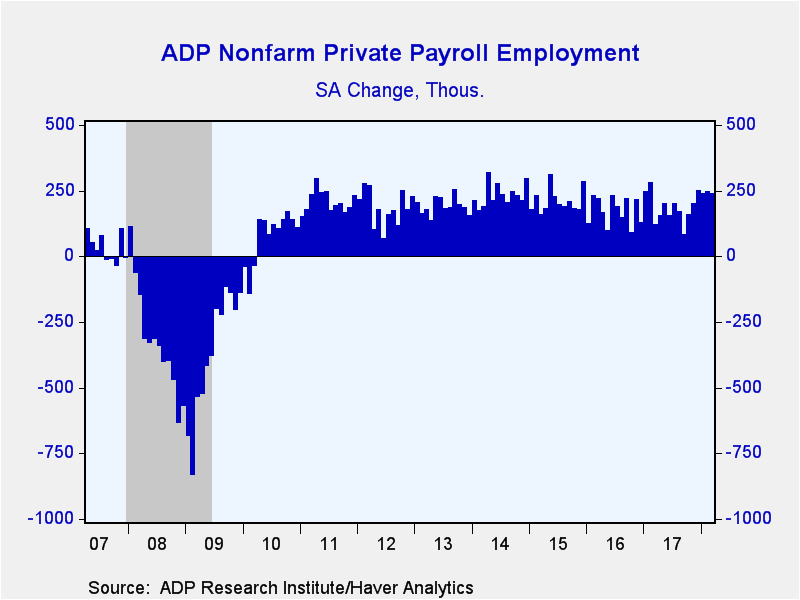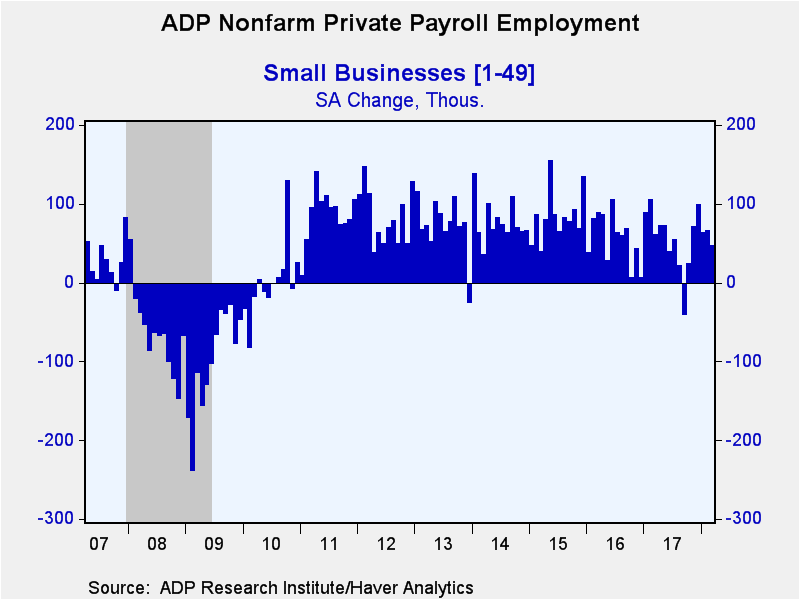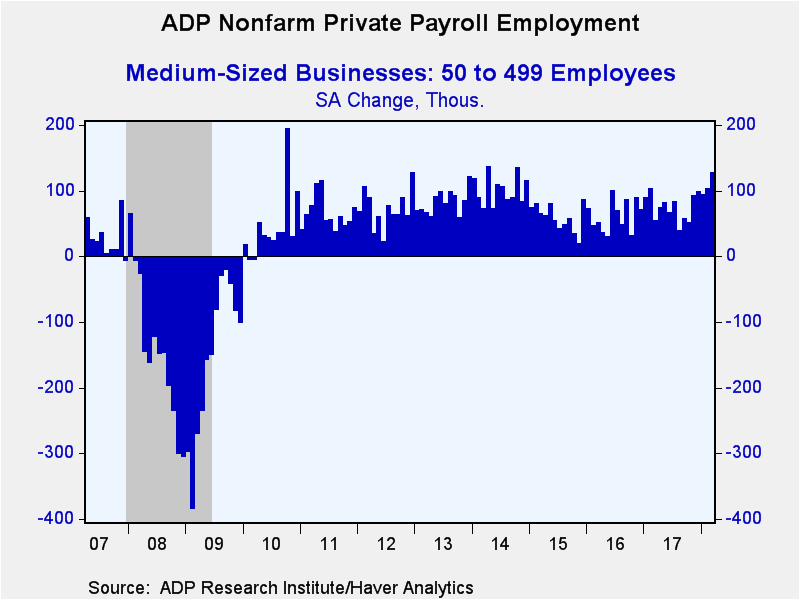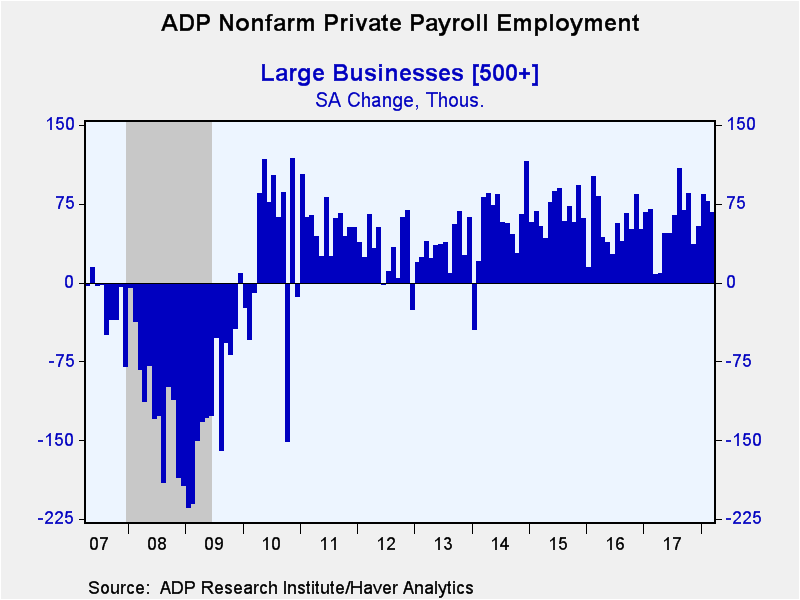 Global| Apr 04 2018
Global| Apr 04 2018U.S. ADP Private Payroll Growth Steadies
by:Tom Moeller
|in:Economy in Brief
Summary
The ADP/Moody's National Employment Report indicated that private nonfarm payrolls increased 241,000 (1.9% y/y) during March following a 246,000 February gain, revised from 235,000. A 210,000 rise had been expected in the Action [...]
The ADP/Moody's National Employment Report indicated that private nonfarm payrolls increased 241,000 (1.9% y/y) during March following a 246,000 February gain, revised from 235,000. A 210,000 rise had been expected in the Action Economics Forecast Survey. Payrolls have risen an average 192,000 during the last twelve months. During the last ten years, there has been a 96% correlation between the change in the ADP figure and the change in nonfarm private-sector payrolls as measured by the Bureau of Labor Statistics.
The Automatic Data Processing Research Institute survey is based on ADP's business payroll transaction system covering 411,000 companies and nearly 24 million employees. The data are processed by Moody's Analytics Inc., then calibrated and aligned with the BLS establishment survey data. The ADP data cover private sector employment only.
Small-sized business hiring increased 47,000 (1.2% y/y) in March, the slowest increase in five months. Medium-sized payrolls gained 127,000 (2.2% y/y), more-than-double the growth early last year. Large-sized payrolls improved 67,000 (2.7% y/y) and improved slightly on the twelve-month average.
Private service-sector payrolls increased a lessened 176,000 (1.8% y/y), the weakest increase in four months. Professional & business services payrolls improved a steady 44,000 (2.7% y/y). The number of trade, transportation and utilities jobs rose a strengthened 40,000 (1.2% y/y), up from slight declines early last year. Education & health services employment rose a lessened 28,000, with y/y growth of 2.1% down from a peak 2.8% in 2016. Employment in the leisure & hospitality sector gained 26,000 (2.0% y/y), the weakest increase in four months. Financial activities jobs rose 18,000 (1.5% y/y), the firmest rise in four months. Employment in the information sector rose an improved 3,000 (-0.6% y/y). Payrolls here have been falling since early-2016.
Employment in the goods-producing sector rose a firmed 65,000 (2.1% y/y). Construction sector payrolls increased 31,000 (2.8% y/y), double the 12-month average. Jobs in the factory sector rose 29,000 (1.5% y/y), also double the twelve-month average. In the natural resource & mining sector, jobs rose a strengthened 5,000 (5.5% y/y).
The ADP National Employment Report data are maintained in Haver's USECON database; historical figures date back to April 2001 for the total and industry breakdown, and back to January 2005 for the business size breakout. The expectation figure is available in Haver's AS1REPNA database.
Do the Employed Get Better Job Offers? from the Federal Reserve Bank of New York can be found here.
| ADP/Moody's National Employment Report | Mar | Feb | Jan | Mar Y/Y | 2017 | 2016 | 2015 |
|---|---|---|---|---|---|---|---|
| Nonfarm Private Payroll Employment (m/m chg, 000s) | 241 | 246 | 241 | 1.9% | 1.8% | 1.9% | 2.3% |
| Small Payroll (1-49) | 47 | 66 | 64 | 1.2 | 1.3 | 1.9 | 1.9 |
| Medium Payroll (50-499) | 127 | 103 | 94 | 2.2 | 1.9 | 1.5 | 2.3 |
| Large Payroll (>500) | 67 | 77 | 84 | 2.7 | 2.3 | 2.7 | 3.0 |
| Goods-Producing | 65 | 42 | 47 | 2.1 | 1.5 | 0.8 | 2.0 |
| Construction | 31 | 25 | 29 | 2.8 | 3.1 | 4.3 | 5.3 |
| Manufacturing | 29 | 14 | 15 | 1.5 | 0.7 | 0.2 | 1.2 |
| Service-Producing | 176 | 204 | 194 | 1.8 | 1.8 | 2.2 | 2.3 |
Tom Moeller
AuthorMore in Author Profile »Prior to joining Haver Analytics in 2000, Mr. Moeller worked as the Economist at Chancellor Capital Management from 1985 to 1999. There, he developed comprehensive economic forecasts and interpreted economic data for equity and fixed income portfolio managers. Also at Chancellor, Mr. Moeller worked as an equity analyst and was responsible for researching and rating companies in the economically sensitive automobile and housing industries for investment in Chancellor’s equity portfolio. Prior to joining Chancellor, Mr. Moeller was an Economist at Citibank from 1979 to 1984. He also analyzed pricing behavior in the metals industry for the Council on Wage and Price Stability in Washington, D.C. In 1999, Mr. Moeller received the award for most accurate forecast from the Forecasters' Club of New York. From 1990 to 1992 he was President of the New York Association for Business Economists. Mr. Moeller earned an M.B.A. in Finance from Fordham University, where he graduated in 1987. He holds a Bachelor of Arts in Economics from George Washington University.










